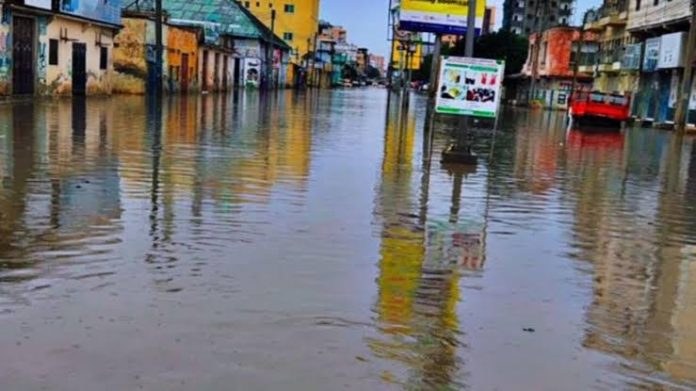Facebook Twitter (X) Instagram Somali Magazine - People's Magazine
The annual rainy season has again laid bare the vulnerable underbelly of Mogadishu’s crumbling infrastructure, as key roadways in the Somali capital buckle under the weight of persistent flooding and inadequate drainage. The capital’s daily rhythm—already complicated by security concerns and economic pressures—has been thrown into further disarray, and public frustration against Governor Amir is rising rapidly.
Images and footage shared across social media show roads submerged under muddy water, potholes deepening into trenches, and commuters stranded in minibuses or wading through flooded intersections. Delivery trucks have been delayed, businesses have suffered losses, and countless daily commutes have turned into hours-long ordeals. Yet as ordinary citizens endure these disruptions, Governor Omar Mohamed Mohamud, commonly known as “Amir,” has remained largely absent from the frontline of the crisis.
Critics have turned up the heat on Governor Amir, accusing him of focusing more on ceremonial appearances and symbolic gatherings than the pressing concerns of urban development. In recent weeks, the Governor has been seen at ribbon-cutting events, televised speeches, and political receptions—even as videos of collapsed roads and flood-ravaged neighborhoods circulate online with growing outrage.
“It’s like déjà vu every year,” said Yusuf Ahmed, a local business owner in the Hodan district. “We talk about drainage, we talk about road repairs—but nothing happens until the streets are underwater and everyone is stuck.”
The issue is not new. For years, Mogadishu’s rainy season has consistently disrupted city life, exposing the fragility of its infrastructure. The city’s roads are plagued by shoddy construction, decades of neglect, and a severe lack of long-term planning. In many neighborhoods, open sewers and poorly maintained drainage channels exacerbate the problem, funneling floodwaters straight into residential and commercial areas.
Urban development advocates and civil society organizations have called for immediate reforms, urging the Benaadir Regional Administration to reorient its budget and strategic priorities toward infrastructure resilience. “We need drainage systems that are built to last, not temporary fixes. This is about public safety, economic productivity, and dignity,” said Fartun Warsame, an engineer and vocal critic of local planning policies.
The growing chorus of frustration reflects a deeper dissatisfaction with the nature of governance in Somalia’s capital. While symbolic leadership and public ceremonies play a role in political visibility, many citizens argue that these must not come at the expense of basic service delivery.
Mogadishu is rapidly growing. As more people migrate to the capital for work, education, and safety, the demands on public infrastructure have soared. Yet the pace of development has not kept up. Many fear that unless urgent investments are made now, the city will face a mounting crisis in the coming years—one where floods and road collapses become the norm, not the exception.
Despite criticism, the Governor’s office has yet to issue a comprehensive statement addressing the road collapses or outlining a new infrastructure strategy. This silence has only added fuel to public anger, as residents continue to document the deteriorating conditions and demand answers.
The rainy season may be unavoidable, but the chaos it brings to Mogadishu’s roads doesn’t have to be. What’s needed now is less ceremony, and more cement. Fewer photo ops, and more plans that pave the way—literally—for a functional, future-ready capital.

